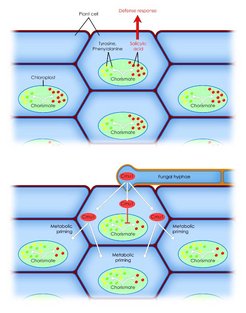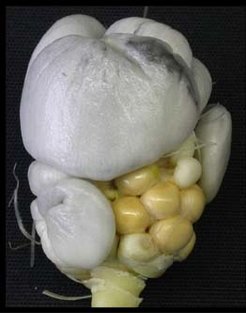Smut fungus has found a new way to switch off plant immune defence
Fungal pathogen manipulates the plant's metabolism to promote the infection of maize plants
Pathogens causing plant diseases are an enormous threat in agriculture. They can spread rapidly and cause massive crop losses, particularly in today’s large-scale monocultures. To infect a plant successfully, pathogens must overcome the intricate defence systems of host plants. By studying the maize smut fungus Ustilago maydis, and working in collaboration with colleagues from several other Max Planck institutes and universities, researchers from the Max Planck Institute for Terrestrial Microbiology in Marburg have discovered how this plant pathogen can reprogram the metabolism of maize cells for its own purposes to allow successful infection. To do this, the fungus secretes a cocktail of proteins, one of which is the enzyme Cmu1, a chorismate mutase. This enzyme is taken up by infected plant cells where it reprograms the plant’s metabolism and suppresses the immune defence of the infected plant. Similar enzymes are also formed by many other plant pathogens. Therefore, this mechanism could be a tool widely used by pathogens to infect plants successfully.

Cmu1 is a component of the shikimate metabolic pathway, through which cells produce tyrosine and phenylalanine – essential amino acids for humans and animals – from the starting material chorismate. Salicylic acid, which plays an important role in the defence against pathogens in plants, is also formed from chorismate. The Marburg-based researchers have now discovered that chorismate mutases, which have long been comprehensively studied, have an entirely new function in plant pathogens.
According to the scientists, the maize smut pathogen secretes different proteins, including Cmu1, into the plant cell. “Cmu1 redirects the plant’s shikimate pathway so that the cells produce less salicyclic acid. The enzyme intervenes directly in the plant’s metabolism and undermines its pathogen defence,” says Regine Kahmann from the Max Planck Institute for Terrestrial Microbiology. Cmu1 also reaches the neighbouring cells via natural cell connections and reprograms them to respond to the needs of the fungus before they are actually infected by the fungus. “However, Cmu1 is just one of many proteins with which the fungus bombards the plant. There can be no doubt that additional strategies to overcome the plant defence are in place,” says Armin Djamei, co-first author of the publication with Kerstin Schipper. For example, U. maydis has two genes for enzymes which can hydroxylate salicyclic acid and convert it to a compound no longer triggering defence.

The researchers found genes for secreted chorismate mutases almost exclusively in plant pathogens which, like Ustilago maydis, are relying on living plant tissue. “Many other microorganisms from this group obviously outsmart plants in this way. If we can prevent pathogens from manipulating plant metabolism with their secreted chorismate mutases, we may have an effective new approach to reducing crop losses in agriculture,” says Regine Kahmann.
HR

